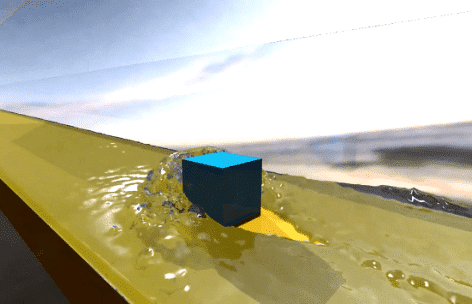
Experimental and Numerical Study on Wave-Impact on Buildings
2Department of Mathematical Science and Advanced Technology (MAT), Japan Agency for Marine-Earth Science and Technology (JAMSTEC)
3Civil Engineering Department, Haute Ecole d'Ingénierie et d'Architecture de Fribourg (HEIA-FR)
Tsunami, impulse waves, dam-break waves and flood surges are rare, but catastrophic events, associated with human losses and damages to infrastructures. At present, the computation of wave-induced loads remains challenging, due to the complexity of the phenomenon. Despite of numerous studies, a more accurate estimation of wave-induced loads is necessary for the design of safer infrastructures and reliable vertical shelters. For this, a comprehensive understanding of the physical phenomenon based on a hybrid experimental-numerical approach is essential.
In literature, most previous studies are based on experimental approaches. The frontal impact on impervious free-standing buildings was widely investigated and a variety of formulae was introduced to estimate wave-induced loads. In addition, previous studies pointed out that a specific design could reduce the impact forces exerted by the incoming wave on the buildings. The presence of openings allowed for a flow through the buildings, decreasing the upstream water depths and increasing the downstream ones, resulting into a linear reduction of the maximum horizontal force, when compared to the corresponding impervious configuration. The orientation of the building also showed to have a key role in the loading process.
The purpose of this research is to compare some experimental tests carried out at Laboratory of Hydraulic Constructions (LCH) at Ecole Polytechnique Fédérale de Lausanne (EPFL) in Switzerland with a numerical model developed at the Japan Agency for Marine-Earth Science and Technology (JAMSTEC). The Smoothed Particle Hydrodynamics (SPH)-based model adopting the explicit time integration method with parallel computing algorithms with a dynamic load balancing technique is used to simulate the impact of tsunami-like waves on buildings. This numerical model was previously validated to correctly reproduce the main hydrodynamic properties of the tsunami-like waves. Herein, these results are applied to the fluid-structure interaction, resulting into a combined approach in the estimation of wave-induced loads (Figure 1). Numerical results showed good agreement with experimental ones. The horizontal forces exerted on buildings with different geometries are herein compared and discussed. This paper shows preliminary results showing that the numerical tool represented a good approach for a better understanding of the physical phenomenon and could thus be used for the design of safer resilient structures.

Figure 1 –Example of SPH numerical simulation for an impervious low-rise building

Powered by Eventact EMS